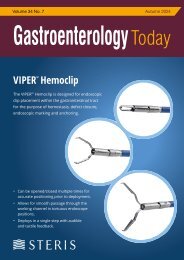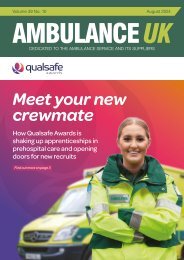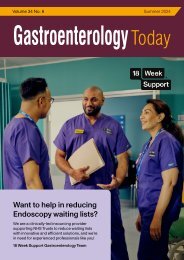Gastroenterology Today Autumn 2020
Create successful ePaper yourself
Turn your PDF publications into a flip-book with our unique Google optimized e-Paper software.
FEATURE<br />
Table 2 Diagnostic tests available in Italy to detect SARS-CoV-2 infection<br />
Method<br />
Real time reverse<br />
transcriptionpolymerase<br />
chain<br />
reaction<br />
Direct amplification<br />
real-time reverse<br />
transcriptionpolymerase<br />
chain reaction.<br />
Diasorin<br />
Simplexa<br />
Solid phase immunochromatographic<br />
assay for the detection<br />
of IgG and IgM<br />
antibodies to SARS-<br />
CoV-2.<br />
Type of specimen<br />
required<br />
Respiratory and<br />
non-respiratory<br />
tract specimens<br />
Nasopharyngeal<br />
swabs<br />
Whole blood,<br />
serum or plasma<br />
Time required for assay Advantages<br />
5–8 h Gold standard for the etiological<br />
diagnosis; high sensitivity and<br />
specificity; high safety<br />
1 h High sensitivity and specificity;<br />
simple protocol with all in one<br />
reagent; rapid response; high<br />
safety; suitable for decentralized<br />
point-of-care<br />
5–15 min No equipment needed; rapid<br />
response; suitable for decentralized<br />
point-of-care; good sensitivity and<br />
specificity; suitable for identifying<br />
asymptomatic patients and for<br />
screening<br />
Limits<br />
Complex protocol; overcoming of the<br />
throughput capacities of the laboratories<br />
with diagnostic delays; not suitable for<br />
decentralized point-of-care<br />
For emergency use authorization only;<br />
Limited literature data; Limited to<br />
laboratories certified to perform high<br />
complexity tests<br />
Not recommended as first line test for<br />
the diagnosis of acute viral infection;<br />
prone to ‘cross reactivity’; few reports<br />
about serological assay in detection of<br />
SARS-CoV-2; uncertain timing of antibodies<br />
development<br />
GASTROENTEROLOGY TODAY - AUTUMN <strong>2020</strong><br />
8<br />
Remote outpatient clinics via telephone or video calls (tele-clinics)<br />
are increasingly utilized to reduce hospital congestion and seminal<br />
experiences in kidney transplantation have registered even higher<br />
attendance rates than conventional clinics in selected patients [10].<br />
Converting a proportion of outpatient clinics appointments to tele-clinics<br />
may reduce transplant population exposure to the virus. Numbers of<br />
visits (even tele-visits) can be reduced selecting only those patients<br />
with new symptoms or active issues, delaying well-being ones. A<br />
policy of remote management of immunosuppression by testing<br />
immunosuppressant level in local laboratories (then transmitted<br />
electronically) can be encouraged, thus relieving the workload on<br />
transplant centers.<br />
Virus tests and transplantation<br />
In transplant services, a delay or failure to diagnose SARS-CoV-2 infection<br />
in a donor may potentially produce disastrous consequences for the<br />
recipient and also increase the risk for health-workers [11]. In this context,<br />
the role of in vitro diagnostics is crucial to screen donors and recipients.<br />
An appropriate diagnostic strategy for the detection of virus infection<br />
involves collecting the correct specimen from the patient at the right time<br />
and performing an accurate and rapid laboratory test (Table 2).<br />
Reverse transcription-polymerase chain reaction<br />
The gold standard technique for detecting the SARS-CoV-2 infection<br />
is the real-time polymerase chain reaction (RT-PCR). This test has<br />
the advantage that the primers required can be produced as soon<br />
as the viral sequence is known. RT-PCR provides high levels of<br />
diagnostic sensitivity and specificity but the test protocol of nucleic<br />
acid amplification is complex and requires specialized instruments<br />
and technicians [12]. Although SARS-COV-2 RNA has been detected<br />
from a variety of respiratory sources, US Centers for Disease Control<br />
and Prevention recommends collecting only the upper respiratory NPS<br />
[13]. This indication is in accordance with Wang et al., that reported<br />
good detection rates of SARS-CoV-2 RNA in NPS (63% of the examined<br />
samples) [14]. SARS-CoV-2 RNA has been also detected from feces<br />
and blood specimens, although less reliably than from respiratory<br />
specimens. Higher viral loads have been detected soon after symptoms<br />
onset; thus, respiratory specimens should be collected within the first<br />
7 days. Missing the time-window of viral replication can cause false<br />
negative results [15, 16]. Several RT-PCR protocols for the detection of<br />
SARS-CoV-2 RNA have been released by the World Health Organization<br />
and nowadays are widely standardized. However, work overload and<br />
logistic difficulties to ship samples to the few specialized centers,<br />
lead to significant delays in response time (up to 4–5 days in remote<br />
hospitals) [17]. This has caused issues in transplant services where<br />
rapid tests are needed to accelerate clinical decision-making. Several<br />
new generation real-time RT-PCR protocols for the detection of SARS-<br />
COV-2 RNA have been recently developed. These assays are suitable<br />
for decentralized point-of-care use and allow obtaining reliable results<br />
within 1 h (actual state-of-the-art detection methods). One of these,<br />
Simplexa COVID-19 Direct (DiaSorin Molecular LLC, CA) received<br />
the FDA’s emergency use authorization and it is nowadays available in<br />
Italy. Simplexa incorporate nucleic acid extraction, amplification and<br />
detection together into an integrated system ensuring a simple, safe<br />
and highly qualitative test [18–20].<br />
Serology<br />
A recent study reported acute antibody responses to SARS-CoV-2 in<br />
285 patients and clarified that antibodies produced during the course<br />
of infection by symptomatic and asymptomatic patients can aid to the<br />
diagnosis of COVID-19 [21]. Immunoassays for detection of SARS-<br />
COV-2 immunoglobulin (Ig) M and IgG antibodies have proven to be<br />
highly specific and sensitive providing diagnostic evidence of infection<br />
in a few minutes. Moreover, the use of serology rapid tests could<br />
facilitate the diagnosis of SARS-CoV-2 infections when the molecular<br />
assays were performed unsatisfactorily [22, 23]. Several companies,<br />
driven by the growing demand of healthcare systems started to<br />
produce rapid immunoassays for SARS-CoV-2. The majority of these<br />
are solid phase immunochromatographic assays for the qualitative<br />
and differential detection in human whole blood, serum or plasma of<br />
IgG and IgM antibodies to SARS-CoV-2. Although the manufacturers<br />
guarantee an accuracy close to 100%, doubts exist in the scientific<br />
community about the time kinetics of humoral response and for the<br />
potential cross reactivity with other coronaviruses [24]. In our opinion,<br />
active surveillance with rapid serological tests may prove a good option<br />
for the screening of asymptomatic donors and recipients.

















